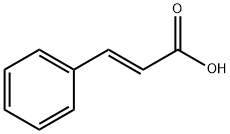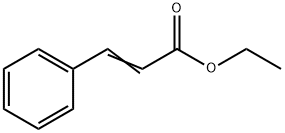Methyl cinnamate , 99% , 103-26-4
CAS NO.:103-26-4
Empirical Formula: C10H10O2
Molecular Weight: 162.19
MDL number: MFCD00008458
EINECS: 203-093-8
| Pack Size | Price | Stock | Quantity |
| 25G | RMB24.00 | In Stock |
|
| 100G | RMB40.80 | In Stock |
|
| 500G | RMB120.80 | In Stock |
|
| 2.5KG | RMB464.00 | In Stock |
|
| others | Enquire |
PRODUCT Properties
| Melting point: | 33-38 °C (lit.) |
| Boiling point: | 260-262 °C (lit.) |
| Density | 1.092 |
| vapor pressure | 0.73Pa at 25℃ |
| FEMA | 2698 | METHYL CINNAMATE |
| refractive index | 1.5771 |
| Flash point: | >230 °F |
| storage temp. | Sealed in dry,Room Temperature |
| solubility | Chloroform (Slightly), Methanol (Slightly), soluble in alcohol, Propylene glycol, Mineral oil and oils. |
| form | Fused Crystalline Mass |
| Specific Gravity | 1.092 |
| color | White to light yellow |
| Odor | at 100.00 %. sweet balsam strawberry cherry cinnamon |
| Odor Type | balsamic |
| Water Solubility | insoluble |
| JECFA Number | 658 |
| Merck | 14,2299 |
| BRN | 386468 |
| InChIKey | CCRCUPLGCSFEDV-BQYQJAHWSA-N |
| LogP | 2.68 at 25℃ |
| CAS DataBase Reference | 103-26-4(CAS DataBase Reference) |
| NIST Chemistry Reference | 2-Propenoic acid, 3-phenyl-, methyl ester(103-26-4) |
| EPA Substance Registry System | Methyl cinnamate (103-26-4) |
Description and Uses
Methyl cinnamate is the methyl ester of cinnamic acid and is a white or transparent solid with a strong, aromatic odor. It is found naturally in a variety of plants, including in fruits, like strawberry, and some culinary spices, such as Sichuan pepper and some varieties of basil. Eucalyptus olida has the highest known concentrations of methyl cinnamate (98 %) with a 2 - 6 % fresh weight yield in the leaf and twigs.
Methyl cinnamate is used in the flavor and perfume industries. The flavor is fruity and strawberry-like; and the odor is sweet, balsamic with fruity odor, reminiscent of cinnamon and strawberry.
It is known to attract males of various orchid bees, such as Aglae caerulea.
Methyl cinnamate crystals extracted using steam distillation from Eucalyptus olida.
Methyl cinnamate is used as a fragrance ingredient in cosmetics and household products.
Safety
| Symbol(GHS) |  GHS07 |
| Signal word | Warning |
| Hazard statements | H317 |
| Precautionary statements | P280 |
| Safety Statements | 22-24/25 |
| WGK Germany | 1 |
| RTECS | GE0190000 |
| TSCA | Yes |
| HS Code | 29163990 |
| Toxicity | Moderately toxic by ingestion . The oral LD50 for rats is 2610 mg / kg . It is combustible as a liquid, and when heated to decomposition it emits acrid smoke and irritating fumes. |



